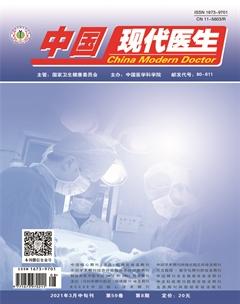不同程度侧支循环对冠状动脉慢性完全闭塞性病变患者心功能的影响
2021-04-30段娜栾波侯爱洁罗德锋
段娜 栾波 侯爱洁 罗德锋
[摘要] 目的 探討不同程度侧支循环对冠状动脉慢性完全闭塞性病变患者心功能的影响。 方法 选取2016年1月至2018年12月辽宁省人民医院接受冠状动脉造影明确诊断至少有一支冠状动脉血管完全闭塞并成功开通的冠状动脉粥样硬化性心脏病患者110例,根据Rentrop分类将患者分为侧支循环不良组(0级或1级)和侧支循环良好组(2级或3级);收集两组患者术前、术后1个月和术后6个月的N端脑钠肽前体指标、6 min步行试验、超声心动图评价的左心室射血分数及左心室舒张期末容积。 结果 术后1个月,两组患者NT-proBNP水平均低于术前(P<0.05);侧支循环不良组术后1个月NT-proBNP水平低于术前,术后6个月水平低于术后1个月(P<0.05);侧支循环良好组术后1个月NT-proBNP水平低于术前(P<0.05),术后1个月和术后6个月NT-proBNP水平比较,差异无统计学意义(P>0.05);不同程度侧支循环与不同时间点NT-proBNP指标存在交互效应(P<0.05);两组患者术后1个月和6个月LVEDD水平均低于术前,LVEF值高于术前,差异有统计学意义(P<0.05),但不存在交互效应(P>0.05);两组患者术后1个月和6个月6 min步行试验距离明显长于术前,差异有统计学意义(P<0.05),同时不同程度侧支循环与不同时间点6 min步行试验距离存在交互效应(P<0.05)。 结论 侧支循环对冠状动脉慢性完全闭塞性病变患者术前心功能及活动耐量有一定的改善作用,并且对于冠状动脉慢性完全闭塞性病变患者成功开通闭塞血管后的心功能改善具有一定的预测价值。
[关键词] 冠状动脉慢性完全闭塞性病变;冠状动脉;侧支循环;心功能
[中图分类号] R542.22 [文献标识码] A [文章编号] 1673-9701(2021)08-0024-05
Effects of different degrees of collateral circulation on cardiac function in patients with chronic complete occlusive disease of coronary artery
DUAN Na LUAN Bo HOU Aijie LUO Defeng
Department of Cardiology, People′s Hospital of China Medical University, People′s Hospital of Liaoning Province, Shenyang 110016, China
[Abstract] Objective To investigate the effects of different degrees of collateral circulation on the cardiac function of patients with chronic complete occlusive disease of coronary artery. Methods A total of 110 patients with coronary atherosclerotic heart disease who underwent coronary angiography and had at least one coronary artery completely occluded and successfully opened in People′s Hospital of Liaoning Province from January 2016 to December 2018 were continuously collected. According to the Rentrop classification, the patients were divided into the poor collateral circulation group(grade 0 or 1) and the good collateral circulation group(grade 2 or 3). The N-terminal pro-brain natriuretic peptide indexes, 6-min walk test, and echocardiography were collected to evaluate left ventricular ejection fraction and left ventricular end-diastolic volume before the operation, at one month after the operation, and six months after the operation. Results One month after operation, NT-proBNP levels in the two groups were lower than those before operation(P<0.05) The level of NT-proBNP at 1 month after operation was lower than that before operation, and that at 6 months after operation was lower than that at 1 month after operation(P<0.05); The level of NT-proBNP in the group with good collateral circulation at 1 month after operation was lower than that before operation(P<0.05). There was no significant difference in the level of NT-proBNP between 1 month after operation and 6 months after operation(P>0.05); There were interaction effects between different degree of collateral circulation and NT-proBNP at different time points(P<0.05); LVEDD at 1 and 6 months after operation was lower than that before operation, LVEF was higher than that before operation, the difference was statistically significant(P<0.05), but there was no interaction effect(P>0.05); The distance of 6 min walking test at 1 month and 6 months after operation in the two groups was significantly longer than that before operation, and the difference was statistically significant(P<0.05). At the same time, there was interaction effect between different degrees of collateral circulation and 6 min walking test distance at different time points(P<0.05). Conclusion The collateral circulation has a certain effect on improving the preoperative cardiac function and activity tolerance of patients with chronic complete occlusive disease of the coronary artery. It has a certain predictive value for the improvement of cardiac function in patients with chronic complete occlusive disease of the coronary artery after successfully opening the occluded vessel.
[Key words] Chronic complete occlusive disease of the coronary artery; Coronary artery; Collateral circulation; Cardiac function
冠状动脉侧支循环(Coronary collateral circulation,CCC)是指连接不同冠状动脉或同一冠状动脉不同部分细小的解剖上存在的微循环血管。在冠状动脉明显狭窄或闭塞时,侧支循环能发挥代偿作用为远端心肌供血,它的形成是冠状动脉血管闭塞后形成的一种代偿机制,与缺乏发达侧支循环的患者相比,良好的侧支循环可减少梗死面积,改善心室功能和存活率[1]。近年来随着慢性完全闭塞(CTO)介入技术,尤其是逆向技术的发展,侧支循环在介入治疗中的意义越来越重要。然而侧支循环在冠心病患者的作用及预后仍存在争议。在急性冠状动脉闭塞的心肌梗死患者中,早期研究结论不同,一些研究显示,良好的侧支血管造影对患者的临床预后有改善作用[2-3],而其他研究则显示无明显差异[4]或预后更差[5]。因此,本研究通过比较成功开通CTO的冠心病患者相关指标,评价不同冠脉侧支循环分级对慢性完全闭塞患者术前及行CTO-PCI术后心功能的影响,现报道如下。
1 资料与方法
1.1 一般资料
选取2016年1月至2018年12月辽宁省人民医院接受冠状动脉造影明确诊断至少有一支冠状动脉血管完全闭塞并成功开通的冠状动脉粥样硬化性心脏病患者110例。CTO被定义为闭塞的动脉,闭塞持续时间至少为3个月,病变处绝对没有血流(TIMI 0级)[6]。排除标准:3个月内发生急性冠脉综合征、失代偿性心力衰竭、既往行冠状动脉旁路移植术者。本研究通过辽宁省人民医院医学伦理委员会批准。
1.2 资料收集
收集所有入选患者的性别、年龄、吸烟饮酒史、高血压史、糖尿病史、血脂异常史、用药史、N端脑钠肽前体(NT-proBNP)、心脏扇扫及心功能、6 min步行试验等指标以及冠脉侧支循环分级。
1.3 冠状动脉介入治疗术
冠状动脉造影及介入治疗采用常规标准介入技术,使用6F或7F引导导管经桡动脉或股动脉入路,CTO开通后常规植入药物洗脱支架。CTO-PCI根据病情采用合适的器械和技术,如双侧造影、特殊的亲水及锥形尖端导丝、平行导丝技术、微导管和逆向入路。导丝、球囊和药物洗脱支架类型的选择由操作医生自行决定。术前,所有患者均被给予负荷剂量的阿司匹林(300 mg/d)、氯吡格雷(300 mg)或替格瑞洛(180 mg)。在手术过程中,静脉注射肝素(100 U/kg)。手术后,给予氯吡格雷(75 mg/d)或替格瑞洛(90 mg/bid)至少12个月,阿司匹林(100 mg/d)长期使用。出院后,除非有禁忌,建议所有患者服用指南推荐的药物,包括他汀类药物、血管紧张素转换酶抑制剂和β-受体阻滞剂,除非有禁忌,并在随访12个月时重复冠状动脉造影。其中CTO-PCI成功的定义是闭塞病变的再通,残余狭窄小于30%,TIMI血流等级为3级[7]。手术成功是指没有死亡、心肌梗死或进行急诊冠状动脉旁路移植术。
1.4 冠状动脉侧支循环的分级
根据Rentrop分类[8],从对侧血管供应完全闭塞远端的冠状动脉侧支程度进行分类:0=任何侧支通道均无可见充盈;1=侧支充盈,无心外膜段显示;2=心外膜动脉部分被侧支充盈;3=侧支血管完全充盈心外膜动脉。0~1级判为侧支循环不良,2~3级判为侧支循环良好。造影结果由两位专科医师阅读造影资料共同判定,根据Rentrop分类将患者分为侧支循环不良组(0级或1级)和侧支循环良好组(2级或3级)。对于存在不同程度侧支循环的患者,选择侧支等级最高的血管进行分析。
1.5 随访及观察指标
所有患者均于PCI术前及术后1个月、术后6个月抽血检测NT-proBNP,进行6 min步行试验、超声心动图检查,并计算左心室射血分数(Left ventricular ejection fraction,LVEF)及左室舒张期末内径(Left ventricularend diastolic dimension,LVEDD)。
1.6 统计学方法
采用SPSS 22.0统计学软件进行数据分析,计量资料以均数±标准差(x±s)表示,采用独立样本t检验,计数资料用[n(%)]表示,采用χ2检验,同一因素不同时间点测量结果采用重复测量方差分析,P<0.05为差异有统计学意义。
2 结果
2.1 基本资料分析
所有入选患者根据侧支循环分级分为侧支循环不良组56例,侧支循环良好组54例,随访6个月,其中侧支循环不良组失访10例,侧支循环良好组失访7例,剩余侧支循环不良组46例,侧支循环良好组47例纳入统计分析。两组的性别、年龄、BMI、心梗病史、糖尿病史、高血压史、高脂血症史、吸烟史、饮酒史及服用ACEI/ARB史比较,差异均无统计学意义(P>0.05)。其中侧支循环良好组2例患者因血压不能耐受未使用ACEI/ARB类药物。
2.2 不同程度侧支循环与不同时间点心功能相关指标比较
术后1个月,两组患者NT-proBNP水平均低于术前(P<0.05);侧支循环不良组术后1个月NT-proBNP水平低于术前,术后6个月水平低于术后1个月(P<0.05);侧支循环良好组术后1个月NT-proBNP水平低于术前(P<0.05),术后1个月和术后6个月NT-proBNP水平比较,差异无统计学意义(P>0.05);不同程度侧支循环与不同时间点NT-proBNP指标存在交互效应(P<0.05);两组患者术后1个月和6个月LVEDD水平均低于術前,LVEF值高于术前,差异有统计学意义(P<0.05),但不存在交互效应(P>0.05);两组患者术后1个月和6个月6 min步行试验距离明显长于术前,差异有统计学意义(P<0.05),同时不同程度侧支循环与不同时间点6 min步行试验距离存在交互效应(P<0.05)。
3 討论
侧支循环的形成是慢性或反复心肌缺血继发的一种代偿机制。近年来,越来越多的研究证明,侧支循环在维持心肌存活中起重要作用。本研究通过统计分析发现,①左心室功能与冠状动脉侧支循环程度有关;②成功的CTO病变血管介入治疗能改善冠心病患者左心室功能。侧支循环能保护缺血的心肌细胞,减少和改善心肌缺血和心肌梗死面积。良好的冠状动脉侧支循环是降低冠心病患者不良心血管事件的重要因素,并与冠心病患者预后有关[9]。有研究发现,对于心肌缺血的区域,良好的侧支循环能减少心肌坏死的程度,并能改善左心室功能不全及减少因此导致的死亡[10]。
血清NT-proBNP水平升高是心功能不全的重要生物学标记,可较准确地反映心肌细胞,尤其是心室肌细胞的功能状态。本研究结果显示,侧支循环不良组术前NT-proBNP水平较侧支循环良好组偏高,但差异无统计学意义。尽管冠状动脉慢性完全闭塞病变的出现被认为是侧支循环形成的先决条件,但是由于动脉粥样硬化的影响,侧支循环的生长机制非常复杂。发达的侧支血供不能完全代替正常的冠状动脉血流[11],因此良好的侧支循环对心肌保护是不够的。成功的CTO血运重建可显著改善所对应心肌的心肌灌注和收缩功能[12],且可进一步改善患者预后[13]。目前关于侧支循环对于心脏功能恢复程度的影响尚无定论。
本研究通过对CTO介入治疗患者的随访,并对术前术后相关指标进行分析比较发现,两组患者术后1个月和6个月的LVEF值和6min步行试验均有所提高,同时NT-proBNP指标和LVEDD均有所下降,进一步证明了成功的CTO介入治疗可改善左室心肌重塑,提高患者的心功能。
成功的CTO介入治疗清除了冠状动脉前向血流的阻力,重建正向血流,导致侧支循环血管阻力增加,随着时间的推移,大多数患者的良好侧支循环在成功再通CTO后会逐渐消退[11],可能导致在成功的CTO介入治疗术后侧支循环良好的患者中,再次血运重建和整体MACE事件的发生率相似或增加。已有研究发现,成功的CTO介入治疗术后支架内再狭窄的发生在侧支循环良好的患者中升高[14]。与非闭塞病变相比,CTO病变血流重建后侧支循环功能减退[15]更明显。早期的研究发现[16],发育良好的侧支循环功能与再狭窄或再闭塞具有相关性,特别是CTO患者成功PCI术后大量的侧支血管竞争恢复的前向血流,导致类似动脉粥样硬化过程的支架内再狭窄。而本研究随访6个月,尚未行冠脉造影检查,但临床指标随访发现,侧支循环良好组患者术后LVEF值明显改善,可能与侧支循环的消退有关。
综上所述,冠状动脉侧支循环对冠状动脉慢性完全闭塞性病变患者术前心功能及活动耐量有一定的改善作用,并且对于冠状动脉慢性完全闭塞性病变患者成功开通闭塞血管后的心功能改善具有一定的预测价值。
[参考文献]
[1] Meier P,Hemingway H,Lansky A,et al.The impact of the coronary collateral circulation on mortality:A meta-analysis[J].European Heart Journal,2012,33(5):614-621.
[2] Desch S,de Waha S,Eitel I,et al.Effect of coronary collaterals on long-term prognosis in patients undergoing primary angioplasty for acute St-elevation myocardial infarction[J].The American Journal of Cardiology,2010,106(5):605-611.
[3] ■en ■,Allahverdiyev S,Topuz M,et al.Clinical significance and determinants of prompt recruitment collaterals during primary percutaneous coronary intervention[J].Kardiologia Polska,2017,75(8):763-769.
[4] Shen Y,Wu F,Pan C,et al.Clinical relevance of angiographic coronary collaterals during primary coronary intervention for acute St-elevation myocardial infarction[J].Chinese Medical Journal,2014,127(1):66-71.
[5] Nicolau J,Nogueira P,Pinto M,et al.Early infarct artery collateral flow does not improve long-term survival following thrombolytic therapy for acute myocardial infarction[J].The American Journal of Cardiology,1999,83(1):21-26.
[6] Danek B,Karatasakis A,Tajti P,et al.Incidence,treatment,and outcomes of coronary perforation during chronic total occlusion percutaneous coronary intervention[J].The American Journal of Cardiology,2017,120(8):1285-1292.
[7] Bucholz E,Normand S,Wang Y,et al.Life expectancy and years of potential life lost after acute myocardial infarction by sex and race:A cohort-based study of medicare beneficiaries[J].Journal of the American College of Cardiology,2015,66(6):645-655.
[8] Rentrop K,Cohen M,Blanke H,et al.Changes in collateral channel filling immediately after controlled coronary artery occlusion by an angioplasty balloon in human subjects[J].Journal of the American College of Cardiology,1985,5(3):587-592.
[9] Marchesseau S,Seneviratna A,Sj?觟holm A,et al.Hybrid PET/CT and PET/MRI imaging of vulnerable coronary plaque and myocardial scar tissue in acute myocardial infarction[J].Journal of Nuclear Cardiology:Official Publication of the American Society of Nuclear Cardiology,2018, 25(6):2001-2011.
[10] Hoole S,White P,Read P,et al.Coronary collaterals provide a constant scaffold effect on the left ventricle and limit ischemic left ventricular dysfunction in humans[J].Journal of Applied Physiology(Bethesda,Md:1985),2012,112(8):1403-1409.
[11] Shen Y,Yang Z,Hu J,et al.Donor artery stenosis interactions with diastolic blood pressure on coronary collateral flow in type 2 diabetic patients with chronic total occlusion[J].Cardiovascular Diabetology,2018,17(1):76.
[12] Pujadas S,Martin V,Rosselló X,et al.Improvement of myocardial function and perfusion after successful percutaneous revascularization in patients with chronic total coronary occlusion[J].International Journal of Cardiology,2013,169(2):147-152.
[13] Olivari Z,Rubartelli P,Piscione F,et al.Immediate results and one-year clinical outcome after percutaneous coronary interventions in chronic total occlusions:Data from a multicenter,prospective,observational study (toast-gise)[J].Journal of the American College of Cardiology,2003,41(10):1672-1678.
[14] Meier P,Indermuehle A,Pitt B,et al.Coronary collaterals and risk for restenosis after percutaneous coronary interventions:A meta-analysis[J].BMC Medicine,2012,10:62.
[15] Ichijo M,Iwasawa E,Numasawa Y,et al.Significance of development and reversion of collaterals on MRI in early neurologic improvement and long-term functional outcome after intravenous thrombolysis for ischemic stroke[J].AJNR American Journal of Neuroradiology,2015,36(10):1839-1845.
[16] Jensen L,Thayssen P,Lassen J,et al.Recruitable collateral blood flow index predicts coronary instent restenosis after percutaneous coronary intervention[J].European Heart Journal,2007,28(15):1820-1826.
(收稿日期:2020-09-22)
